When it comes to property damage, you might think storm damage and water damage are the same, but they're not. Storm damage usually stems from severe weather conditions, while water damage often results from issues like leaks or plumbing failures. Understanding these differences is essential for effective management and restoration of your property. Ignoring the specifics can lead to costly mistakes in repairs and insurance claims. So, what should you know about identifying the signs and guiding the repair processes for each type?
Definition of Storm Damage
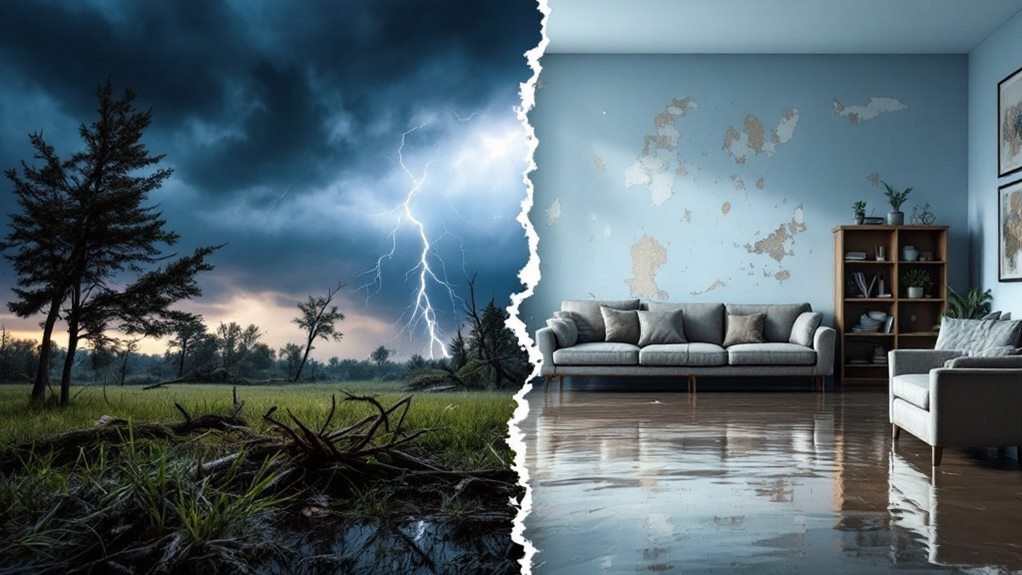
Understanding storm damage requires you to contemplate how weather patterns change over time. As these patterns shift, they can lead to more intense storms, which in turn means more destruction. Think of it as a game of dodgeball, but instead of dodging balls, you're dodging flying debris.
When evaluating storm damage, you'll want to look for structural issues, broken windows, and other signs that your property has taken a beating. Remember, the aftermath can be as unpredictable as the weather itself. One minute you're sipping lemonade on your porch, and the next, you're surveying a tornado's handiwork. So, keep your sense of humor handy, for confronting the aftermath of storm damage can be overwhelming, but it's likewise a wild ride worth sharing—with a few laughs and a dash of resilience.
Definition of Water Damage
Water damage refers to the deterioration caused by excessive water exposure, impacting structures and belongings. Understanding the various types and causes of water damage is essential for effective prevention and remediation. By identifying these factors, you can better protect your property from potential harm.
Types of Water Damage
There are several distinct types of water damage, each stemming from different sources and posing unique challenges. Understanding these types can help you navigate the murky waters of recovery.
Here's a quick breakdown for you:
| Type of Water Damage | Flood Classification | Moisture Assessment |
|---|---|---|
| Clean Water Damage | Category 1 | Low moisture levels |
| Grey Water Damage | Category 2 | Moderate moisture |
| Black Water Damage | Category 3 | High moisture levels |
| Storm-Related Damage | Varies | Varies |
| Sewage Backup | Category 3 | High moisture levels |
Clean water comes from sources like a burst pipe, while grey water is a tad more questionable, think washing machine overflow. Black water? Let's just say you don't want to be swimming in that. The flood classification helps you identify the severity, while moisture assessment guarantees you know how wet your situation really is. So, whether you're dealing with a leaky sink or a full-blown flood, knowing these types can save you from a soggy mess and maybe a few tears.
Causes of Water Damage
When a pipe bursts or heavy rain causes a flood, the potential for water damage escalates. You might think of water damage as just a soggy carpet or an unexpected indoor swimming pool, but it's more serious than that. It can stem from various sources, including faulty plumbing, roof leaks, or even appliances like dishwashers and washing machines. Yes, that innocent-looking washing machine could be plotting against you!
In many cases, water damage occurs gradually, allowing mold to throw an unwelcome party in your home. That's where flood prevention and water mitigation come in. By addressing leaks promptly and maintaining your plumbing, you can keep water where it belongs—outside.
Don't underestimate the impact of minor issues, like a loose connection under the sink. Ignoring them could lead to major catastrophes, like a water feature in your living room that you never wanted. Remember, while you can't control the weather, you can control your home's defenses. So take a proactive approach; after all, nobody wants to turn their house into a water park!
Causes of Storm Damage
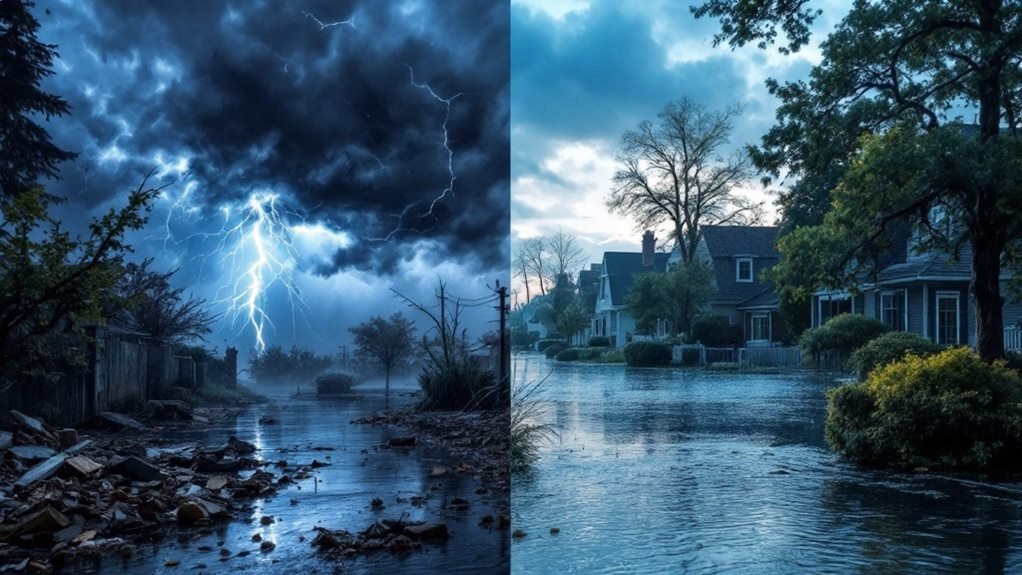
Storm damage often stems from two main causes: wind and debris impact, in addition to flooding and rainfall effects. High winds can dislodge objects and create projectiles, while heavy rainfall can overwhelm drainage systems, leading to flooding. Understanding these causes is vital for evaluating the extent of storm-related damage.
Wind and Debris Impact
As wind speeds escalate during severe weather events, the risk of damage from airborne debris considerably increases. You might think your garden gnome is safe, but when a gust hits, it turns into a projectile! The wind impact can send anything not secured flying, leading to extensive property damage.
Conducting a thorough debris assessment post-storm is essential. You'll want to identify which items are now part of your lawn's new decor. Here's a quick look at how wind and debris can wreak havoc:
| Type of Debris | Potential Damage |
|---|---|
| Tree Branches | Roof punctures, broken windows |
| Outdoor Furniture | Dents in cars, siding damage |
| Signage and Fencing | Injuries to people, property damage |
Understanding the types of debris and their potential effects can help you prepare and minimize damage. So, while you may enjoy watching the wind whip through the trees, remember to secure those lawn chairs before they go on their own adventure—unless you fancy a new gnome-free yard!
Flooding and Rainfall Effects
Here are three key effects of flooding you should consider:
- Structural Damage: Water can weaken foundations, causing cracks and potential collapse. That's not exactly what you want when you're showing off your home to guests.
- Mold Growth: The moisture creates a perfect breeding ground for mold and mildew. Your home could start to smell like a gym sock that's been left in a locker for too long.
- Electrical Hazards: Water and electricity don't mix well. Flooding can lead to short circuits and fire hazards, which is definitely not the party trick you had in mind.
Understanding these impacts helps you prepare and protect your property against the unpredictable effects of rainfall. Stay dry out there!
Causes of Water Damage
Water damage can stem from a variety of sources, each with the potential to cause significant issues in your home. First up, we have plumbing issues. Those pesky pipes can spring leaks faster than you can say "water bill." Cracks, corrosion, or even a loose connection can release a torrent that turns your living room into a mini pool. Fun, right?
Next, let's talk about appliance leaks. Your trusty washing machine or refrigerator might seem harmless, but one little malfunction can lead to a water disaster. Imagine finding your kitchen floor resembling a slip-and-slide! Not exactly the fun summer day you envisioned.
Weather-related incidents, like heavy rain or snowmelt, can likewise contribute to water damage. If your gutters are clogged, you might as well set up a water feature in your yard. Finally, foundation issues can allow groundwater to seep into your home, making your basement a less-than-ideal wine cellar.
In short, whether it's plumbing issues or appliance leaks, the sources of water damage are as diverse as the excuses you give for not doing laundry. Stay vigilant, and you might just keep your home dry!
Signs and Symptoms
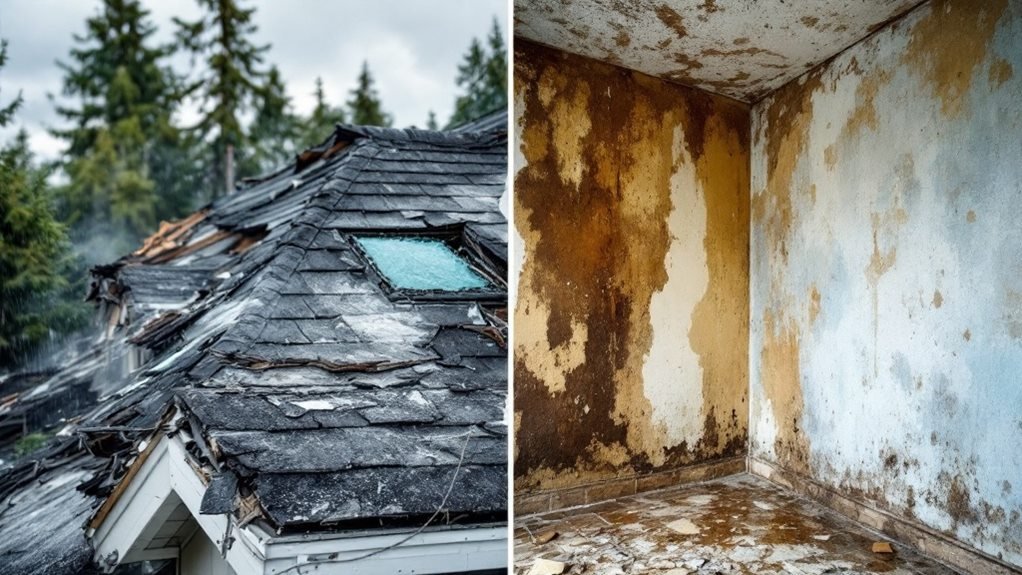
Detecting water damage early can save you from costly repairs and headaches. You don't want to be that person who uncovers a problem too late, right? Here are some signs and symptoms to watch for:
- Water stains: Look for discoloration on walls or ceilings. They often appear like unhappy rain clouds, lurking where they shouldn't be.
- Mold growth: If you're evaluating mold, a musty smell is a telltale sign that you've got moisture problems. Mold can be sneaky, so keep an eye out for green or black patches in corners or behind furniture.
- Peeling paint or wallpaper: If your walls start to look like they're shedding their skin, it's time to investigate. This often indicates excess moisture and could mean you're recognizing leaks.
If you notice any of these signs, don't ignore them! Early action can prevent a small issue from blossoming into a full-blown aquatic crisis. So grab your detective hat and start probing; your home will thank you!
Repair and Restoration Process
The repair and restoration process begins as soon as you identify water damage. First, you'll want to engage an emergency response team that can assess the situation faster than you can find your old mop. They'll help you contain the damage and prevent any further loss—because you don't want that water spreading like gossip at a family reunion.
Next, they'll develop a restoration timeline. This isn't a race, but you'll want to act quickly. The longer you wait, the more problems you face, like mold or structural issues that make your house resemble a scene from a horror movie.
Once the initial assessment is done, the actual restoration begins. This typically involves drying out the affected areas, removing damaged materials, and repairing structural elements. Imagine a home makeover show, but instead of fabulous decor, you're focusing on salvaging your sanity and safety.
Throughout this process, communication is key. Stay in touch with your restoration team to guarantee everything's on track. Remember, a little humor can go a long way, especially when your living room resembles a swamp!
Insurance Considerations
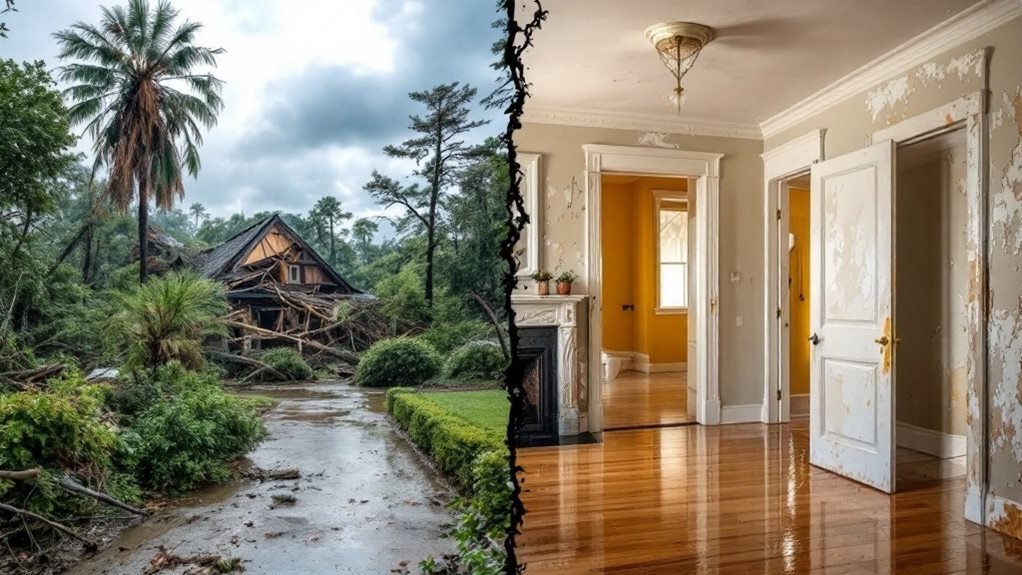
Understanding your insurance coverage is vital when dealing with storm or water damage. It can feel like deciphering an ancient script, but it's fundamental for your sanity and financial health. Here are three key considerations to keep in mind:
- Policy Coverage: Not all policies are created equal. Some cover storm damage, while others might leave you high and dry (pun intended). Make sure you know what your policy covers and what it doesn't.
- Claim Process: Prepare yourself for the claim process. It can sometimes feel like a game of Monopoly—lots of paperwork and the occasional "Go back to start." Familiarize yourself with the steps and necessary documentation so you're not left scrambling.
- Exclusions: Read the fine print! Some policies exclude damages caused by flooding or specific storm-related incidents. You don't want to find out the hard way that your basement flood isn't covered due to the fact that you didn't check.
Frequently Asked Questions
What Are the Long-Term Effects of Storm Damage on Property?
Storm impact can lead to structural weaknesses, mold growth, and decreased property value. You should conduct a thorough property assessment to identify issues early, preventing costly repairs and keeping your wallet happy—because nobody likes surprise expenses!
How Can I Prevent Future Water Damage in My Home?
Ever wonder how to keep your home dry? Improve drainage systems and implement waterproofing techniques; they'll help you dodge future water damage. After all, no one wants a surprise indoor swimming pool, right?
Are There Specific Building Materials Resistant to Storm Damage?
When you're choosing storm resistant materials, consider innovations like impact-resistant windows and reinforced roofs. These options not only protect your home but additionally add a dash of style—who said safety can't look good?
How Does Climate Change Affect the Frequency of Storm Damage?
As storm clouds gather, you notice storm intensity rising and flooding patterns shifting. Climate change's grip tightens, turning once-rare events into regular occurrences, leaving you pondering how to protect your home from nature's increasingly wild tantrums.
Can I DIY Repairs for Minor Storm or Water Damage?
You can tackle minor storm repair or water restoration yourself, but don't forget your toolbox! Just be sure to research proper techniques, or you might end up with a DIY disaster instead of a masterpiece.
Conclusion
Understanding the differences between storm damage and water damage is vital for effective property management. While storm damage often stems from severe weather events, water damage typically arises from plumbing issues. Recognizing the signs early can prevent further complications. Whether you're facing broken windows or leaking pipes, addressing these issues promptly is imperative. By knowing the unique characteristics of each type, you can navigate repairs and insurance claims more effectively, ensuring your property remains safe and sound.

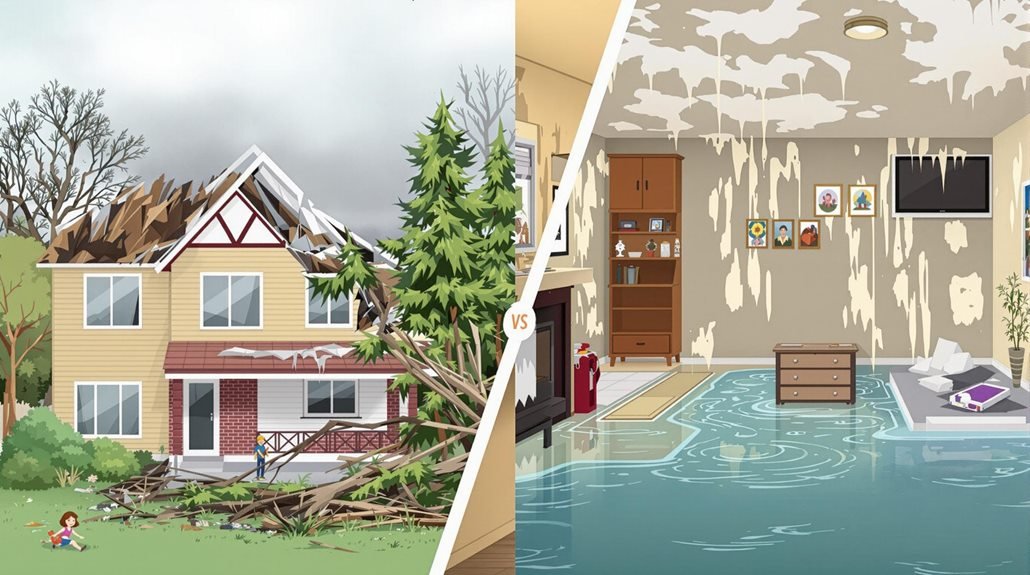
Recent Comments